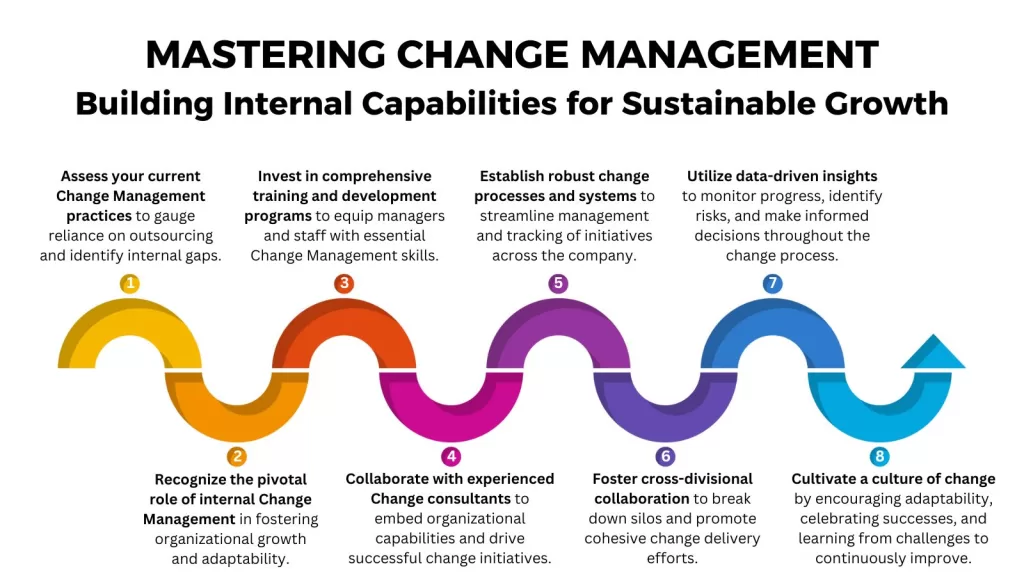
Are you outsourcing too much of your Change Management?
Given the rapid pace of industry changes across numerous industries and sectors, it is not surprising that most companies are dealing with at least several significant change initiatives. For many companies, the approach is to hire a Change practitioner as a contractor to carry out various tasks so that change is managed.
Is this the right approach? Is hiring contractor Change practitioners considered outsourcing too much of a core management responsibility and capability? Smaller companies may not have the luxury of having full-time Change practitioners on staff, so wouldn’t this be the best approach? For larger companies with multiple change initiatives, wouldn’t this also be the best approach to cater to business needs and achieve resource efficiency? In many countries, this seems to be the standard approach. Is this wrong?
Firstly, is change management a core part of management and leadership? Most would agree that, given the rapidly changing industries we are facing, change management forms a key requirement for successful leadership, and that a leader simply will not be successful without good Change Management skills.
This is also widely supported by most authorities: There are numerous Harvard Business Review articles on this, with one calling out that “Change is one of the skills leaders need at every level” (Zenger & Folkman, 2014). Warren Bennis, whom I had the pleasure of meeting at conferences (and who sadly passed away a few years ago), continually acknowledged that “a leader has to be able to change an organization”. Jack Welch was renowned as a strong leader in driving total cultural change at GE, and Marissa Mayer is applauded for driving significant product changes at Yahoo within a short period of time.
So, if Change Management is a core part of management and leadership what are the risks of outsourcing this activity?

One company I consulted for was a large Australian company with several large-scale change initiatives being rolled out concurrently. What struck me about this company was that Change Management was treated more as a project activity that is outside of Operations and can therefore be managed through additional project staff such as contractors. Managers were more than happy to send communications to staff and to participate in various Change Management activities, but did not see this as their core accountability. The common perception by managers was that the external Change practitioner’s job was to help them execute the initiative, more as a pair of hands to do the work.
As a result, what typically happened with larger transformations was that it was hard to drive behavioral change that led to clear business results because Managers did not feel they owned this personally. By the time management had realized that targeted benefits were not achieved, the project had folded and contractors had moved on to the next project.
The typical scenario then was management blaming contractors and providers and other extraneous business factors. Even for those initiatives that had somehow landed well without significant management sponsorship, the result was that the company had not progressed in building change capability, year in year out. Luckily, this was a government-regulated industry with little industry competition. In other industries, this company would basically not be able to survive.
From this example, you can see that if the approach was to continually outsource Change Management, there is a risk that managers do not sufficiently own and drive the initiative, and results will therefore not be achieved. Moreover, the company not only incurs more cost to rely on external support, but it also risks not developing the ability to implement the changes outlined in its strategy and successfully drive initiatives to compete in a changing industry.
So, developing one’s Change Management capability is critical. However, lots of companies have spent significant investment in sending managers and staff to various training courses to learn how to better deal with or manage change. It is not always the case that change capability investment leads to improved organizational capability, or even people capability. Why? There could be myriad reasons for this. This is like asking why training investment doesn’t always lead to direct workplace application and therefore business benefits. We can probably all name training courses we’ve been on where we felt inspired; however, the enthusiasm started to wane as soon as we left the training session.
Recommended approaches to build change capability
How would one develop change capability in a way that will lead to sustained capability improvement and business results? There are several approaches that I recommend:
- For companies lacking in fundamental change management capability, hire a change consultant who can work with you on leading change initiatives and embed business capability development as a part of the work. Key up-and-coming talents may be selected to participate in the project. However, the key is to look for consultants who have experience in developing broad organizational capabilities (vs. skills training) as well as project delivery. This may involve coaching managers, conducting brown-bag sessions, facilitating change agent sessions, facilitating planning sessions, aligning with the performance management system, etc.
- For companies wishing to acquire a broader level of change capability, training may help to provide a clear understanding. However, without direct application of what was learned and receiving ongoing feedback to master the skill, the learning may simply remain on the shelf. Again, after training has been rolled out, work with Change practitioners who can design ongoing capability development as a part of initiative planning & execution to further embed the learning.
- For larger companies with numerous concurrent change initiatives, work on developing change processes and systems to manage the overall portfolio of initiatives. This includes developing an integrated view and a central repository of change initiatives, details of initiative impact (including employee, business, and customer impacts), benefits targeted, and delivery risks.
A robust, integrated view of changes across the company should also be complemented by operating rhythms where regular dashboards and reports are fed into Operations and Leadership discussions. This ensures that managers regularly review the progress of changes, are aware of identified risks, and can make data-based decisions to maximize benefit realization. The onus is on managers to be accountable for the successful progress of initiatives.
At an enterprise level, an integrated operating rhythm for Change Management will also help break silos and highlight cross-divisional work required in successful change delivery. This essentially means that managers across divisions can regularly discuss change implementation issues and risks, and work together to overcome these.

———————————————————————–
References
- Reinventing Leadership: Strategies to Empower the Organization (2005), by Warren G. Bennis and Robert Townsend, p. 91
- “The Skills Leaders Need at Every Level”, Jack Zenger and Joseph Folkman, July 20, 2014, Harvard Business Review